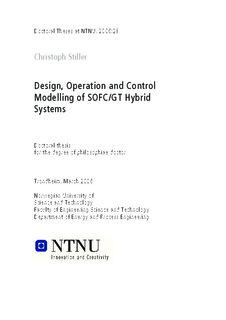| dc.description.abstract | This thesis focuses on modelling-based design, operation and control of solid oxide fuel cell (SOFC) and gas turbine (GT) hybrid systems. Fuel cells are a promising approach to high-efficiency power generation, as they directly convert chemical energy to electric work. High-temperature fuel cells such as the SOFC can be integrated in gas turbine processes, which further increases the electrical efficiency to values up to 70%. However, there are a number of obstacles for safe operation of such a system, such as fuel cell damage through thermal loads or undesired chemical reactions, or gas turbine problems related to high thermal capacity and volume of the pressurised components. Development of suitable plant design as well as operation and control strategies is hence a key task for realisation of the mentioned systems.
The first part of the thesis describes the utilised models. All component models that have been developed and applied for the work are mathematically defined based on a fixed pattern. The thermodynamically most relevant components are tubular SOFC, indirect internal reformer and heat exchangers, and spatially discretised models are used for these. For the turbomachinery, map-based steady-state behaviour is modelled. Gas residence times and pressure drops are accounted for in all components they are relevant.
Based on the component models, three different hybrid cycles are examined. In the first cycle, the SOFC replaces the combustion chamber of a recuperated single-shaft turbine. The SOFC is pressurised and the cycle is called “directly integrated SOFC cycle” (DIC). Further cycle options are a DIC with a two-shaft gas turbine (DIC-2T) and an indirectly integrated SOFC cycle (IIC). In the latter, the compressed gas is heated recuperatively with the exhaust gas and the SOFC is operated at ambient pressure by connecting its air inlet to the turbine exhaust. All cycles incorporate the SOFC system design proposed by Siemens-Westinghouse, including indirect internal reforming, a tubular SOFC bundle and anode recirculation by an ejector. The first cycle (DIC) is regarded as standard cycle.
Objectives for highly efficient, safe system design are formulated and design parameters are associated. A design calculation determines the design parameters for the standard cycle, based on a nominal power output of 220 kW. The design LHVbased electric efficiency is app. 63%. Related to the design point, steady-state part-load ability of the system is analysed and displayed in two-dimensional performance maps where each axis represents one degree of freedom. Degrees of freedom considered are fuel and air flow; fuel utilisation is assumed constant. A result is that a strategy with constant mean fuel cell temperature is most advantageous in terms of safe and gentle operation. Further advantages of this strategy are the ability for low part-load and high efficiency at part-load operation.
A control strategy is derived for dynamical implementation of the found part-load strategy. The system power output is primarily controlled by the SOFC power. The fuel utilisation is kept within certain bounds and the fuel flow is manipulated to control it to its design value. The fuel cell temperature is controlled by the air flow, which again is controlled by manipulating the GT shaft speed through the generator power. To determine the required air flow, a mixed feedforward and feedback strategy is used, where the feedforward part calculates a prediction based on the net power output and the feedback part provides correction based on the measurement of the SOFC fuel outlet temperature. Additional constraints to the control system are the supervision of the shaft speed and the valid operation regime of the anode recirculation ejector.
The proposed control strategy provides robust control. The mean SOFC temperature, however, shows large transient deviation upon large load steps. The time to reach the setpoint power for large load steps is up to 70 s, while small load steps are followed in typically 1-2 s. A conclusion is that the system is suitable for load following operation as long as small load steps occur, as for example in distributed power generation for residential applications.
Shutdown and startup strategies are introduced where the gas turbine provides air for cooling/heating throughout the procedures. Additional equipment and piping such as an auxiliary burner, a turbine exhaust throttle, a bypass around the recuperative heat exchanger as well as nitrogen and hydrogen supply and mixing units are required. Therewith, smooth cooling/heating of the cell can be accomplished without external electric power, but with a considerable amount of fuel and flushing nitrogen required.
A further analysis investigates fuel flexibility of a system designed for methane: Hydrogen can be utilised without larger system modifications; only the control system characteristics must be adapted. Because no endothermic steam reforming takes place, the power output is, however, reduced to 70% of the original value, and efficiency is reduced to 55%. Applying the additional equipment required for shutdown/startup, the power can be increased to 94% of the original value, although at a further efficiency decrease. In order to use ethanol as fuel in the ejector-driven anode, a recuperative vaporiser must be applied in the fuel channel. Supposed that reliable reforming catalysts for ethanol can be provided, 88% of the original power output can be achieved at a high efficiency of 62%.
The investigation of the other cycle options reveals that a two turbine cycle where the power turbine is rotating at constant speed, mostly differs in terms of controllability. For controlling the air flow, another handle such as variable inlet guide vanes or air bypass around the SOFC system is required. The indirectly integrated SOFC cycle (IIC) has a significantly lower efficiency of only 56%, assuming the SOFC at the same temperature level than in the DIC. | nb_NO |
